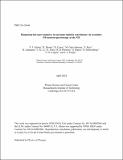| dc.contributor.author | Adrian, Patrick J. | en_US |
| dc.contributor.author | Bionta, R. | en_US |
| dc.contributor.author | Casey, D. | en_US |
| dc.contributor.author | Gatu Johnson, Maria | en_US |
| dc.contributor.author | Kerr, S. | en_US |
| dc.contributor.author | Lahmann, Brandon | en_US |
| dc.contributor.author | Li, Chi-Kang | en_US |
| dc.contributor.author | Nora, R. | en_US |
| dc.contributor.author | Petrasso, Richard D. | en_US |
| dc.contributor.author | Rigon, G. | en_US |
| dc.contributor.author | Schlossberg, D. | en_US |
| dc.contributor.author | Séguin, Frederick H. | en_US |
| dc.contributor.author | Frenje, Johan A. | en_US |
| dc.date.accessioned | 2025-03-21T20:23:27Z | |
| dc.date.available | 2025-03-21T20:23:27Z | |
| dc.date.issued | 2024-04 | |
| dc.identifier | 24ja066 | |
| dc.identifier.uri | https://hdl.handle.net/1721.1/158739 | |
| dc.description | Submitted for publication in Physics of Plasmas | |
| dc.description.abstract | The directional energy spectrum of neutrons generated from the in-flight fusion reaction of 1-MeV tritons contains information about the hot-spot symmetry. The National Ignition Facility (NIF) fields Symmetry Capsule (Symcap) implosions, which have historically measured the symmetry of the radiation, drive by measuring the hot-spot shape via x-ray self-emission. Symcaps are used to tune the hot-spot symmetry for ignition experiments at the NIF. This work shows the relationship between directional secondary DT-n spectra and x-ray imaging data for a large database of Symcap implosions. A correlation is observed between the relative widths of the DT-n spectra measured with nTOFs and the shape measured with x-ray imaging. A Monte Carlo model, which computes the directional secondary DT-n spectrum, is used to interpret the results. A comparison of the x-ray and secondary DT-n data with the Monte Carlo model indicates that 56% of the variance between the two datasets is explained by a P2 asymmetry. More advanced simulations using HYDRA suggest that the unaccounted variance is due to P1 and P4 asymmetries present in the hot spot. The comparison of secondary DT-n data and x-ray imaging data to the modeling shows the DT-n data contain important information that supplements current P2 measurements and contain new information about the P1 asymmetry. | |
| dc.publisher | AIP | en_US |
| dc.relation.isversionof | doi.org/10.1063/5.0210125 | |
| dc.source | Plasma Science and Fusion Center | en_US |
| dc.title | Diagnosing hot-spot symmetry in surrogate ignition experiments via secondary DT-neutron spectroscopy at the NIF | en_US |
| dc.type | Article | en_US |
| dc.contributor.department | Massachusetts Institute of Technology. Plasma Science and Fusion Center | |
| dc.relation.journal | Physics of Plasmas | |
